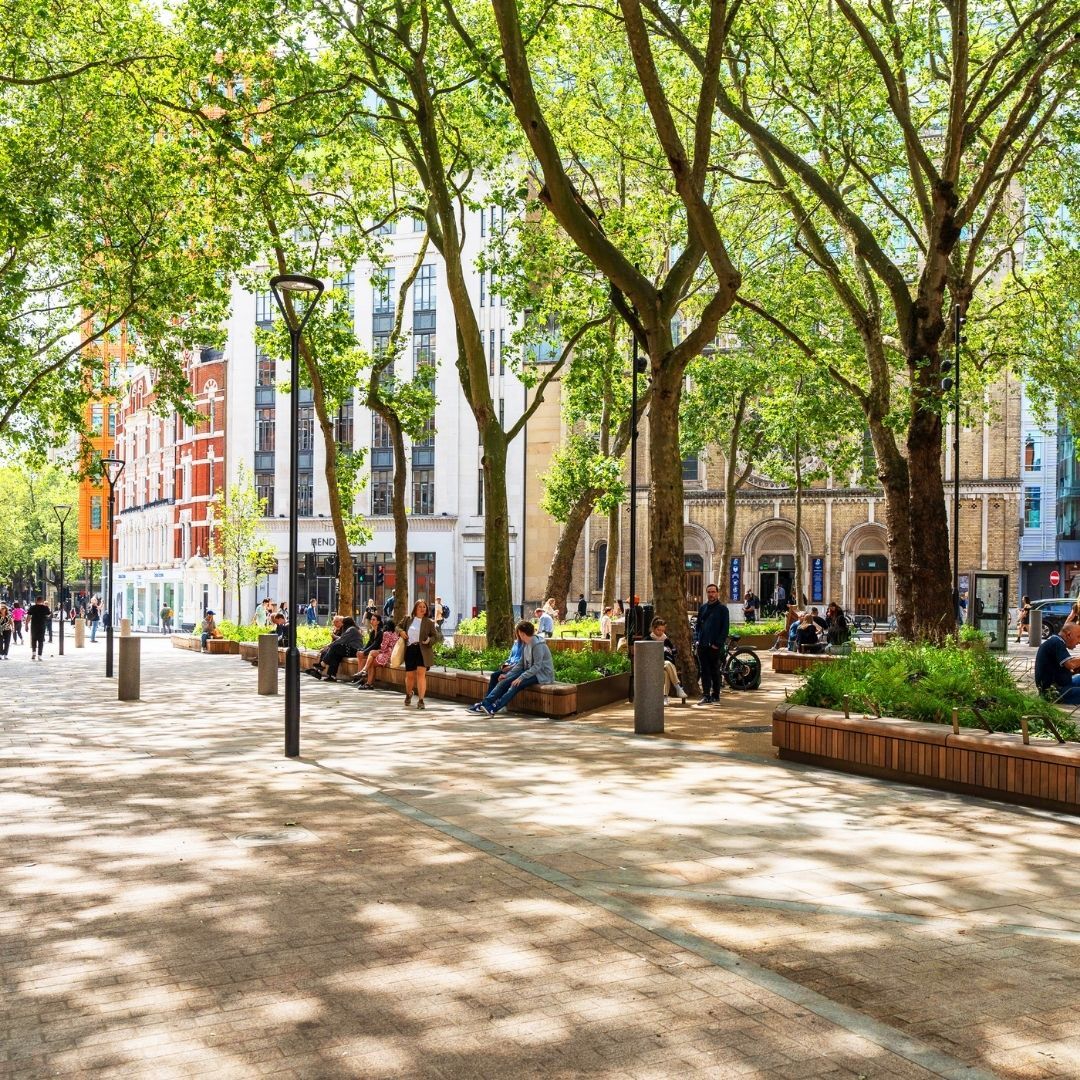Get updates from The Developer straight to your inbox Yes, please!
West End Project, London Borough of Camden for Camden Council - with Central District Alliance, LDA Design, Norman Rourke Pryme, Arcadis and Michael Grubb Studio

Camden Council’s £35m investment into the area around London’s Tottenham Court Road aims to dramatically enhance urban public space. The project reclaims road space for 0.7ha of new parks, squares and incidental pocket plazas and the re-imagining of 0.3 hectares of existing space. Removing the one-way systems and reducing traffic on Tottenham Court Road and Gower Street. The planting plan includes over 1,000m2 of new beds and borders.
Who is on the project team? (designer, consultants, etc)
Landscape Architects: LDA Design
Civil, M&E and Structural Engineers: Arcadis Construction
Project Management and Cost Consultancy: Norman Rourke Pryme
Lighting Design: Michael Grubb
Studio Contractor: ID Verde
Overarching West End Project Strategy: DSDHA
Describe the context of this project, its neighbourhood and people.
West End Project is Camden Council’s £35m investment into the area around London’s Tottenham Court Road. It is a pioneering healthy streets and spaces initiative and the borough’s largest transport and public realm scheme, designed to improve air quality and health and wellbeing; strengthen climate resilience; and transform the experience for pedestrians, cyclists, families, workers, residents and visitors. This complex renewal programme unpicks decades of vehicular dominance to demonstrate the benefits of a softer, greener, more social city. It includes removing the one-way systems and reducing traffic on Tottenham Court Road, Gower Street and across neighbouring streets; the transformation of community treasure Whitfield Gardens and the creation of seven pocket parks. Alfred Place Gardens is the first new park in the area for 25 years. Princes Circus claims part of Shaftesbury Avenue and Bloomsbury Street to create a lively new public square. Road space has been reclaimed, 0.9 hectares of public space created, pavements widened and decluttered and 2.6km of cycle lanes added. Safety has improved, as has wayfinding and connections to the British Museum and Covent Garden. Bus journeys along Tottenham Court Road are quicker; air quality is better than pre-lockdown. Strong partnership has made WEP ambitious and inclusive, with Camden Council working with LDA Design as lead designer, Norman Rourke Pryme as project managers, and partners Central District Alliance (Princes Circus), and TfL. The project has been shaped by residents, businesses and local interest groups, with an initial 1,300 responses to early proposals.
How does this public space bring people together, encourage inclusivity, and make a positive environmental impact to the wider place? How is the community engaged in the project?
Starting in 2014, WEP completed in 2023. Working with the community was a priority from the outset and initial engagement got over 1,300 responses from residents, businesses and local interest groups which shaped the project. A series of well-publicised workshops and pop-ups in the spaces, backed by online activity, captured hundreds of meaningful conversations. Greening and nature came up in nearly all conversations, as did the need for generous seating in an area desperately short of quality public spaces. The designs reflect both priorities, with flower-rich perennial and structural planting. All the spaces bring a diverse range of people together, with each providing a sociable setting for life to play out. Whitfield Gardens features communal dining and movable seating; Alfred Place Gardens features long, sculptural seating ideal for chatting, and Princes Circus provides a range of seating, including with ample arm and back rests, supporting people with impaired mobility. In addition, seven pocket parks have created a network of habitats and social spaces. Spaces have been designed to be flexible to support community events and local business. Generous play has been incorporated to cater for families. By creating green and equitable spaces people want to spend time, dwell time has increased. Princes Circus, a previously hostile environment for pedestrians and cyclists, has become two inclusive well-lit, linked public spaces creating an invitational route between Covent Garden and the British Museum, and a much needed square to support Shaftesbury Theatre.
Please share any data or figures that support your entry about how this public space or landscape intervention has made a positive social or environmental impact, for example biodiversity, increased dwell time, flood or drainage mitigation, wellness or safety or other ecosystem services
Drastic change is needed to reduce reliance on fossil fuels. The more we live locally in every aspect of our lives, the faster we combat climate change. Traffic volume is reduced along Tottenham Court Road by up to 70% during the day and on Gower Street by up to 45%. Air quality has improved with NO2 levels 34% lower on Tottenham Court Road and 37% lower on Gower Street than in 2018. Outside the larger schemes, seven pocket parks restrict vehicle access in places which were pedestrian unfriendly. Where cycling is monitored on Tottenham Court Road, it is up both in the week and on the weekend, including by 85% on Sunday between July 2021 and March 2022. Bike hire is up too. The area was hit by Covid downturn and public realm improvements have helped increase footfall, supporting businesses and attracting new ones. In March 2022, a pedestrian count showed an increase of 231% compared to 2021. WEP is contributing to London as a sponge city, by greatly expanding soft landscape areas wand through introducing 2,433m2 of permeable paving, which slow discharge of stormwater. Alfred Place Gardens in particular delivers a substantial new water catchment area. There are 59 new trees to add to the 77 mature trees retained. WEP has delivered 1,134m2 of new planting area, planted with 8,292 herbaceous and structural new plants and 13,252 bulb plants, a mix of flower-rich natives and non-natives to improve biodiversity, pollination and bio-resilience.
Sign up to our newsletter
Get updates from The Developer straight to your inbox
Thanks to our organisation members
© Festival of Place - Tweak Ltd., 124 City Road, London, EC1V 2NX. Tel: 020 3326 7238